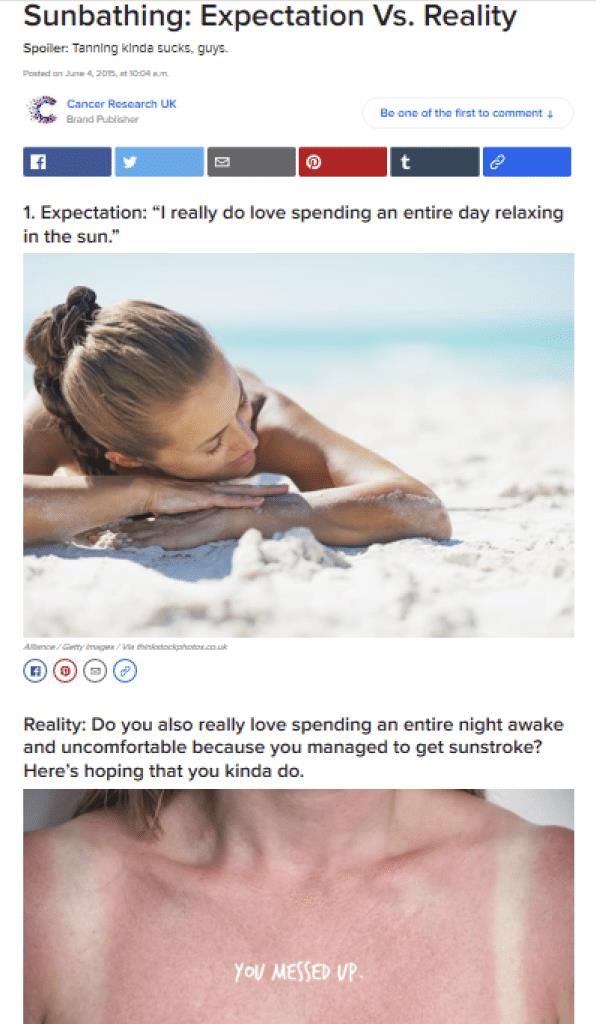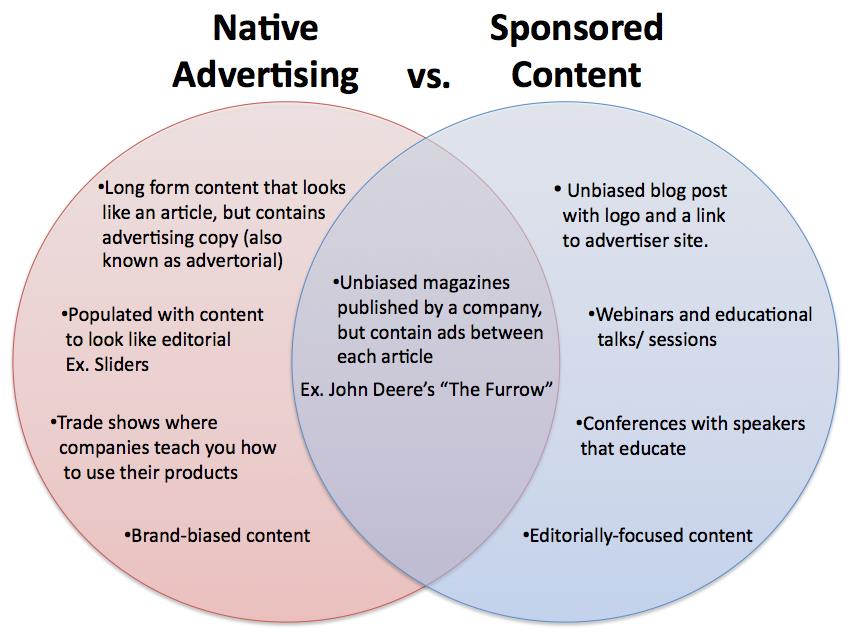Sponsored content, sometimes described as “native advertising,” is a controversial topic in the world of content marketing. While we’ve covered the great content quantity vs. content quality debate many times, we also wanted to cover an area where we see a lot of brands getting into some trouble.
The reasons for this controversy are clear: Sponsored content is often advertising masquerading as pure editorial content, which can be easily misconstrued by the audience.
Sponsored content must be clearly labeled if there’s a relationship between the author and brand. Recent rule changes have clarified expectations, and when done right, this content can benefit all parties, as long as it’s high quality and fully disclosed.
Quick Takeaways
- Sponsored content is an increasingly popular way for brands to advertise and publishers to generate income.
- It’s important to understand advertising disclosure rules so you stay out of trouble or a PR disaster.
- Sponsored content must be presented carefully to avoid losing the trust of your audience.
- Publishers and brands should work together on conforming to all required standards.
- Clear labeling builds transparency and keeps everyone on the right side of the rules.
What Is Sponsored Content?
But before we get into exactly what those rules are, let’s define exactly what we’re talking about here.
Sponsored content is promotional content that is paid for by a sponsor and published on someone else’s website, blog, social media account, or other platform.
In some cases, the content may be provided by the sponsor. Other times the sponsor may leave the publisher to create it, with stipulations on the general content topic, included keywords, and links.
Examples of sponsored content might include:
- A photograph of an influencer wearing an item of clothing provided and paid for by a brand.
- A blog post comparing different VPN services that is sponsored by a particular VPN provider.
- A video on YouTube with a message at the start that a particular advertiser sponsored it.
Ideally, it should be clear to the reader when content is sponsored, and the content should fit in with the rest of the content on the publisher site and provide some kind of value to the audience.
However, this does not always happen. Publishers not disclosing a financial relationship with a sponsor or publishing content that does not align with their audience can quickly erode the trust they have built with their audience and even result in legal issues.

Image source
What’s the Difference Between Sponsored Content and Native Advertising?
Native advertising and sponsored content are used interchangeably, but there is a subtle difference. It looks somewhat similar to a traditional ad, and most users will be able to immediately identify it as such. Some examples of native advertising include:
- Sponsored listings at the top of search results
- Promoted listings on shopping websites like eBay or Amazon
- Ads in social media feeds on platforms like Facebook and Instagram
- Recommendation widgets at the end of blog posts
Most native advertising is not a form of content marketing. Just look at my definition of content marketing for more clarification!
You can’t build an audience with native advertising, and the ads rarely provide value in the form of information or entertainment that high-quality content does.
On the other hand, sponsored content as described in the previous examples does not necessarily look like an ad. While it may — and should! — be disclosed as such, you must be able to remove the reference to the sponsor without reducing the value of the content to the audience.

Image source
The Two Rules of Sponsored Content
For both publishers and sponsors to use sponsored content in an ethical way that’s beneficial to all, it’s important to follow these two basic rules:
1. Create great content.
2. Always provide full disclosure.
Why are these rules so important? Well, the No. 1 rule of content marketing is to create great content. This rule shouldn’t change just because the content is sponsored.
Remember, as a content marketer you have a responsibility to your audience to provide value. Content that doesn’t give anything back to your audience won’t be engaging, won’t convert, and essentially won’t offer anything to the advertiser. In other words, it’s a waste of time and money.
Even worse, if you publish low-quality content on your site just because you’re paid to do so, you’ll be compromising your integrity as a publisher and losing your authenticity. Your audience will only put up with so many pieces of bad sponsored content before they lose trust in you entirely. Don’t risk losing your audience by publishing bad content, whether you’re getting paid for it or not.
So let’s look at the second rule: Just why is it so important to provide full disclosure?
It’s the Law
Well, for one thing, it’s the law. The Federal Trade Commission (FTC) has specific guidance for online publishers and is very clear that any connection to a brand must be disclosed when publishing content that can be considered as an endorsement for that brand.
Your Audience Wants Honesty
Secondly, being transparent with your audience that content is sponsored from the start shows that you respect them and that you’re not trying to pull the wool over their eyes for a quick buck.
Brand Journalism and Disclosure
There’s a video where SAP’s former CMO Jonathan Becher (@jbecher), discussed “brand journalism, disclosure, and sponsored content” with one of the leading independent analysts in the IT industry, Jon Reed (@JonERP).
Brands Need to Join the Conversation
The open discussion they had around the importance of full disclosure, about the need for brands to get involved in the conversation, to become like publishers and to reach out to new audiences with quality content was very exciting.
Jon and Jonathan spoke about a few very specific SAP examples. Here’s a summary of their points at a more generic or abstract level since they apply to any brand or marketer or content contributor.
The key messages were:
- A strong brand will have active and socially engaged employees.
- Contributors on any site should fully disclose their employer and any paid arrangements.
- Companies are beginning to realize that in order to reach a larger audience, they need to think like publishers.
- Leading companies are creating content destinations that provide high-valuable content to potential customers. Disclosure is an important issue for these sites as well.
The Media is Shifting
Jon Reed framed the discussion by outlining that there is a big shift in the media. There is brand journalism. Brands often sponsor content, alongside advertisements and this raises issues of disclosure, transparency and authenticity.
Jon mentioned that there is some criticism of brands who produce great content as members of an active community and then also produce sponsored content which “has a whole different vibe.”
According to former SAP CMO Jonathan Becher, everyone is struggling with the question of what is our message vs. what is someone else’s message. “The lines are blurring,” he says. Everyone agrees that brand employees should be part of the conversation and interact with the community.
But should brands censor their own “promotional” messages or certain voices? Jon Reed said “we’re all being paid by someone.” And so they both agreed that employees and other evangelists should all be part of the conversation as long as they achieve this full disclosure: explain who is paying you and for what?
Third-Party Channels Are Important
But then Jonathan explained that brands are always looking to achieve greater reach. To achieve that, to participate in new conversations in other communities, brands need to reach out to third-party channels.
When a brand participates on a third-party site, there should be full disclosure that you are a brand employee. And if the space is paid for, that should also be disclosed. Bottom line is that authors of content should disclose their employer and should disclose if they are getting paid to write an article.
The pair also discussed the need for brands to become like publishers and magazine editors and develop sites that “earn eyeballs” through use of thought leadership, featured content and news. These sites should set the bar high for the quality of the content. And they need to be meticulous about disclosing transparent relationships and presenting a balanced view.
Video source
Making Sponsored Content Work: Strategy and Ethics
For sponsored content to succeed, it needs to deliver value while meeting ethical standards. Start by optimizing for search without sacrificing authenticity—integrate keywords naturally into the text so the content flows like any other piece on your site. Avoid keyword stuffing or awkward phrasing, as that can quickly erode trust.
Ethically, the goal is to strike a balance between promotion and usefulness. Readers should walk away with real information or insight, not just an ad in disguise. Clear disclosures and honest messaging help maintain transparency, while thoughtful content that answers questions or solves problems helps build long-term credibility. When content is both useful and compliant, it benefits everyone involved.
How We Do Sponsored Content At Marketing Insider Group
For some of our more mature clients who are looking for guaranteed traffic to the content we create for them, we use contextual advertising to natively promote our client’s content.
But we don’t do this blindly. Of course we follow the 2 rules mentioned above (create great content, always provide full disclosure).
Native Platforms
We use native platforms like Outbrain and Taboola to serve up “You might also like” or “From around the web” suggestions. But through the use of AI-driven algorithms, we only show this content to audiences who have engaged in similar content before. We only show it to them on platforms where they are likely to engage with the content.
Paid Media
And most importantly, when a reader clicks on the ad, they come and read the article on our client’s website. So we are using paid media to deliver “owned media” visitors.
High Click Through Rates
And because of the contextual nature of the ad, we deliver extremely high click through rates (+2% vs. the average 0.05% for digital banner ads) at extremely low costs per click (less than $0.20 vs. $2.00 CPCs for the industry).
How Sponsored Content Can Benefit All
It’s becoming increasingly difficult for brands to charge for premium content when consumers expect it to be free. Sponsored content is an alternative way for publishers to generate revenue and pay their creators to generate more high-quality content.
And when produced with care and integrity, sponsored content brings value to all parties. But it’s critical to keep the two central rules in mind at all times:
Create great content. Always provide full disclosure.
If you need a hand with your sponsored content, Marketing Insider Group offers specialized services to create content, manage campaigns, and engage with your audience. Contact us today to learn more or book your free consultation with our team!
Read More
By: Lauren Basiura
Title: The 2 Rules of Sponsored Content You’re Not Allowed to Forget
Sourced From: marketinginsidergroup.com/content-marketing/the-2-rules-of-sponsored-content/
Published Date: Tue, 05 Aug 2025 13:00:00 +0000
.png)





